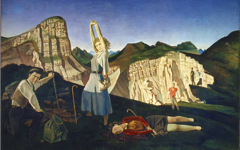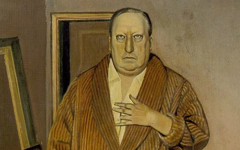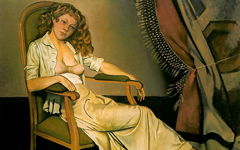Balthus’ The Mountain (1937) Part 2
In Part I of Balthus' The Mountain we showed how the two rock formations in the background are shaped like the head of Poussin in his 1650 Self-Portrait along with the personification of Painting to the left. Others have already shown how the reclining figure fast asleep is based on Poussin's Narcissus, the legendary inventor of Painting, but what about the man with the pipe and the girl stretching?
Click next thumbnail to continue

Left: Balthus, Detail of The Mountain (1937)
Right: Balthus, Detail of Self-Portrait (1940)
Click image to enlarge.
The man bears a remarkable similarity to a Self-Portrait believed to have been painted three years later. The eyebrows and frown are so identical that Balthus must have identified with the pipe-smoking man. Pipes are a traditional symbol in art for imagination while the frown, from Giorgione onwards, is symbolic of the artist's intellectual activity.
Click next thumbnail to continue

Left: Balthus, Detail of The Mountain (1937)
Right: Poussin, Detail of Self-Portrait (1650), inverted
Click image to enlarge.
The girl, meanwhile, modeled by Balthus' future wife, has Poussin's hair from the same self-portrait. It is long, wavy and centrally parted. That cannot be coincidence. I am not suggesting that she did not have hair like that but, if she did, Balthus chose her and painted her for this very reason.
Click next thumbnail to continue
Now that all three foreground figures have been linked to art and the artist, we get a better understanding of the whole scene. The mountains in Balthus' painting are, I believe, metaphors for the mind and brain, their craggy rock formations distantly resembling in color and form the pattern of the cerebral cortex. The grass growing above demonstrates their creative fertility too.
See conclusion below
The landscape's similarity to a brain is also why we only see the top of Poussin's head in the mountain, from the eyes upwards. The figures, then, rambling about on a sunny day are in Balthus' mind, a mind whose creative faculty descends from Poussin and honors him.
As with all interpretations there is far more in this painting than has been explained in this entry. Yet this more accurate picture of what the artist intended will surely help both you and future interpreters find the right framework to think in.
More Works by Balthus
Notes:
Original Publication Date on EPPH: 11 Apr 2011. | Updated: 0. © Simon Abrahams. Articles on this site are the copyright of Simon Abrahams. To use copyrighted material in print or other media for purposes beyond 'fair use', you must obtain permission from the copyright owner. Websites may link to this page without permission (please do) but may not reproduce the material on their own site without crediting Simon Abrahams and EPPH.





